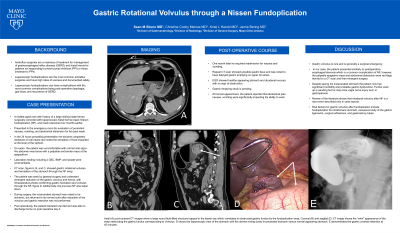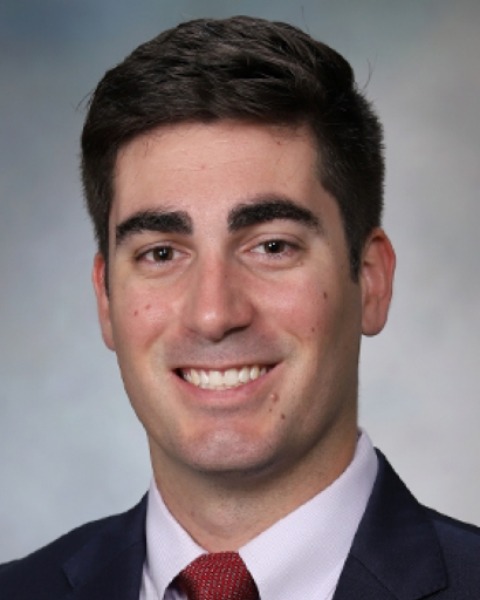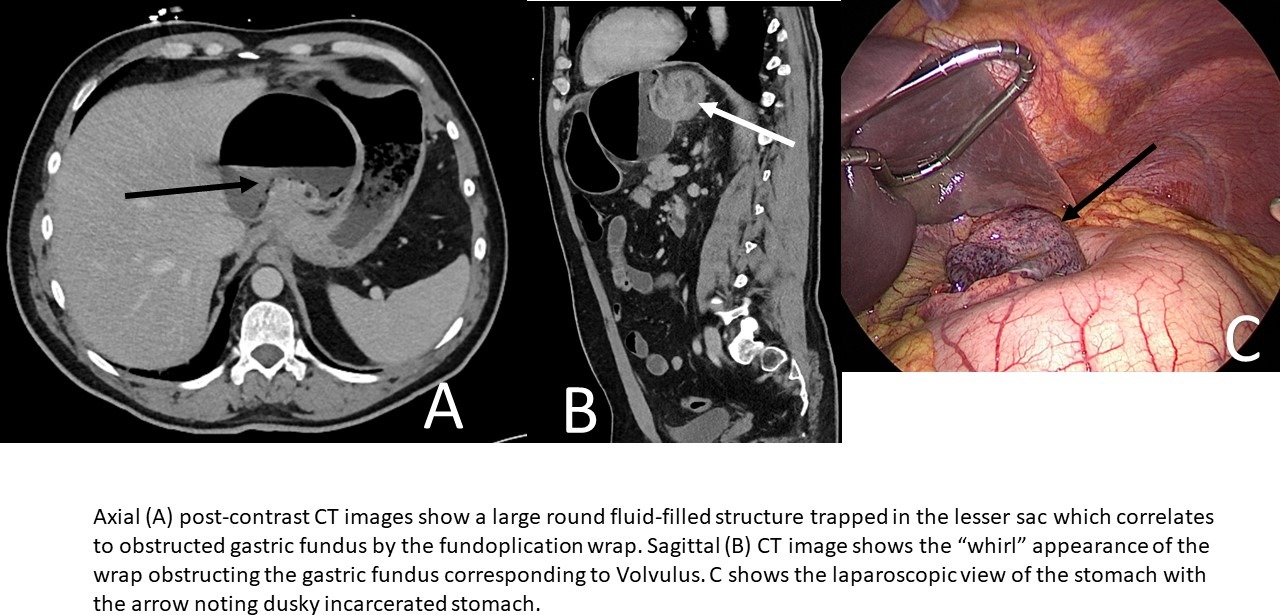Sunday Poster Session
Category: Stomach
P1409 - Gastric Rotational Volvulus Through a Nissen Fundoplication
Sunday, October 22, 2023
3:30 PM - 7:00 PM PT
Location: Exhibit Hall

Has Audio

Sean Sileno, MD
Mayo Clinic
Scottsdale, AZ
Presenting Author(s)
Sean Sileno, MD1, Christine Cooky O. Menias, MD1, Kristi Harold, MD1, Jamie Bering, MD2
1Mayo Clinic, Scottsdale, AZ; 2Mayo Clinic Arizona, Scottsdale, AZ
Introduction: Antireflux surgeries are a mainstay of treatment for management of gastroesophageal reflux disease (GERD) and hiatal hernia for patients not responding to proton pump inhibitors (PPI) or those intolerant to PPIs. Laparoscopic fundoplications are the most common antireflux surgeries and have high rates of success and documented safety. However, laparoscopic fundoplication can have complications with the most common being post-operative dysphagia, gas-bloat, and recurrence of GERD.
Case Description/Methods: A middle-aged man with history of a large sliding hiatal hernia surgically corrected with laparoscopic hiatal hernia repair, Nissen fundoplication (NF), and mesh placement six months earlier presented to the emergency room for evaluation of persistent nausea, vomiting, and abdominal distension for the past week. In the 24 hours preceding presentation he became completely intolerant of oral intake and noted the sensation of food impacted at the level of the xiphoid. On exam, the patient was uncomfortable with normal vital signs. His abdomen was tense with a palpable and tender mass at the epigastrium. CT scan, figure A & B, showed gastric rotational volvulus and herniation of the stomach through the NF wrap. The patient was seen by cardiothoracic surgery and underwent emergent reduction of the gastric volvulus and hernia, with intraoperative photos confirming gastric herniation and volvulus through the NF, figure C. Additionally, the previous NF was taken down. During surgery, the incarcerated stomach was noted to be ischemic, but returned to its normal color after reduction of the volvulus and gastric resection was not performed. Post operatively, the patient tolerated oral diet and was able to discharge home after 2 days.
Discussion: Gastric volvulus is a rare, but life-threatening complication after NF. In our case, the patient presented similarly to postoperative esophageal stenosis which is a much more common complication of NF. However, the palpable epigastric mass and abdominal distension were red flags that led to a CT scan and then emergent surgery. Review of the literature shows that rotational volvulus after NF is a rare event described in case reports. Risk factors for gastric volvulus in this situation include fundoplication for intrathoracic stomach, excessive laxity of the gastric ligaments, surgical adhesions, and gastrostomy tubes.

Disclosures:
Sean Sileno, MD1, Christine Cooky O. Menias, MD1, Kristi Harold, MD1, Jamie Bering, MD2. P1409 - Gastric Rotational Volvulus Through a Nissen Fundoplication, ACG 2023 Annual Scientific Meeting Abstracts. Vancouver, BC, Canada: American College of Gastroenterology.
1Mayo Clinic, Scottsdale, AZ; 2Mayo Clinic Arizona, Scottsdale, AZ
Introduction: Antireflux surgeries are a mainstay of treatment for management of gastroesophageal reflux disease (GERD) and hiatal hernia for patients not responding to proton pump inhibitors (PPI) or those intolerant to PPIs. Laparoscopic fundoplications are the most common antireflux surgeries and have high rates of success and documented safety. However, laparoscopic fundoplication can have complications with the most common being post-operative dysphagia, gas-bloat, and recurrence of GERD.
Case Description/Methods: A middle-aged man with history of a large sliding hiatal hernia surgically corrected with laparoscopic hiatal hernia repair, Nissen fundoplication (NF), and mesh placement six months earlier presented to the emergency room for evaluation of persistent nausea, vomiting, and abdominal distension for the past week. In the 24 hours preceding presentation he became completely intolerant of oral intake and noted the sensation of food impacted at the level of the xiphoid. On exam, the patient was uncomfortable with normal vital signs. His abdomen was tense with a palpable and tender mass at the epigastrium. CT scan, figure A & B, showed gastric rotational volvulus and herniation of the stomach through the NF wrap. The patient was seen by cardiothoracic surgery and underwent emergent reduction of the gastric volvulus and hernia, with intraoperative photos confirming gastric herniation and volvulus through the NF, figure C. Additionally, the previous NF was taken down. During surgery, the incarcerated stomach was noted to be ischemic, but returned to its normal color after reduction of the volvulus and gastric resection was not performed. Post operatively, the patient tolerated oral diet and was able to discharge home after 2 days.
Discussion: Gastric volvulus is a rare, but life-threatening complication after NF. In our case, the patient presented similarly to postoperative esophageal stenosis which is a much more common complication of NF. However, the palpable epigastric mass and abdominal distension were red flags that led to a CT scan and then emergent surgery. Review of the literature shows that rotational volvulus after NF is a rare event described in case reports. Risk factors for gastric volvulus in this situation include fundoplication for intrathoracic stomach, excessive laxity of the gastric ligaments, surgical adhesions, and gastrostomy tubes.

Figure: Axial (A) post-contrast CT images show a large round fluid-filled structure trapped in the lesser sac which correlates to obstructed gastric fundus by the fundoplication wrap. Sagittal (B) CT image shows the “whirl” appearance of the wrap obstructing the gastric fundus corresponding to Volvulus. C shows the laparoscopic view of the stomach with the arrow noting dusky incarcerated stomach.
Disclosures:
Sean Sileno indicated no relevant financial relationships.
Christine Cooky Menias indicated no relevant financial relationships.
Kristi Harold indicated no relevant financial relationships.
Jamie Bering indicated no relevant financial relationships.
Sean Sileno, MD1, Christine Cooky O. Menias, MD1, Kristi Harold, MD1, Jamie Bering, MD2. P1409 - Gastric Rotational Volvulus Through a Nissen Fundoplication, ACG 2023 Annual Scientific Meeting Abstracts. Vancouver, BC, Canada: American College of Gastroenterology.
